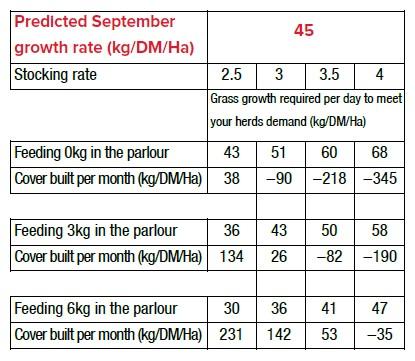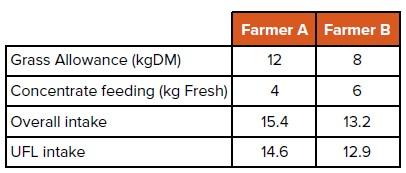Get a 24 hour weather forecast
By LIAM STACK, M.Agr.Sc
Ruminant Technical Manager
As we reach September and beyond, we need to extend our rotation lengths and build a wedge of grass to carry us through to housing. We need to spread fertilizer, to encourage maximum grass growth and lower our farms demand for grass.
Across the month of August, we should have increased our farm covers to c.1000kgDM/ha from 500-600kgDM/ha. We need to continue building covers to mid-September. From there, if we’ve planned correctly, we should have a nice wedge of grass to carry us to housing.
Across the early month of September, we generally need to build a further 100-200kg grass DM/ha depending on our farms stocking rate.
Without concentrates your cows will eat 17kg DM of grass daily (higher yielding cows will have a higher demand of c.25%). At a stocking rate of 2 cows per ha on the milking platform that’s a grass demand of 34kg DM daily, at a stocking rate of 3 cows per Ha that’s a demand of 51kg DM daily. Every 3 kg of concentrates you feed drops grass demand by 2.5kgDM/day per cow. At stocking rates of 2.5+ a minimum of 3 kg of concentrates is required to allow grass covers to build.
At higher stocking rates up to 6 kg and/or grass silage may be required.
In previous years if you have been building these covers without the additional feeding you have been either:
• under feeding your cows to build covers, this will start a yield and lactose decline
• not building your cover adequately forcing early housing

2. Magnesium, trace elements and vitamins needed
a. Leafy autumn grass is high in potash, therefore Mg is required to guard against tetany
b. Autumn grass is low in Se, Cu, I, Zn
3. Manage BCS
Milking cows gain condition more efficiently than dry cows. Take action now to ensure cow BCS is on target. A failure to correct BCS now will leave cows with a BCS of 2.75 or less in October requiring special attention. These cows will need high feeding rates at grass or an extended dry period.
4. Maintain Milk Lactose
Milk lactose is affected by stage of lactation and energy nutrition. Every effort must be taken to keep lactose percentages as high as possible now to prevent milk
price deductions and forced early drying off.
Lactose levels of less than 4.45% affect your monthly balance score card, if your lactose levels are less than 4.2% it will affect both your balance score card and monthly base price.
Reasons for low lactose – Low energy intake:
Autumn grass is generally lower in DM, sugar and UFL than summer grass. As we move into the autumn more concentrates are required for the same level of production as is required by summer grass. Higher levels of concentrate feeding alone is no guarantee of high levels of energy intake or milk lactose %. Higher levels of concentrates must come in conjunction with an overall higher daily intake.
For example:
Farmer B below is feeding 2kg more concentrates to his cows than Farmer A but he is allocating 4kg DM less grass daily. His cows total daily intake is 15% lower (15.4kg DM daily vs 13.2 kg DM daily) and energy intake is 12% lower (14.6 UFL vs 12.9 UFL) than farmer A.
Farmer B despite feeding more concentrates will have a lower lactose.
Reason = over estimating grass allocation to his cows

What to do if lactose is low?
As with all milk constituents your bulk tank is the best place to assess your cow’s diet. If your lactose is lower than it should be or falling faster than it should be you need to allocate more feed (total) to your cows.
If farmer B above allocates 2kg DM more grass to his cows his lactose will improve.
If farmer B is heavily stocked and cannot afford to allocate more grass to his cows, he can either:
a. feed the 6 kg of concentrates + an additional 2kg of extra concentrates to his cows
b. feed the 6 kg of concentrates and add an additional 3kg DM grass silage (1 bale per 75 cows per day) to his cows